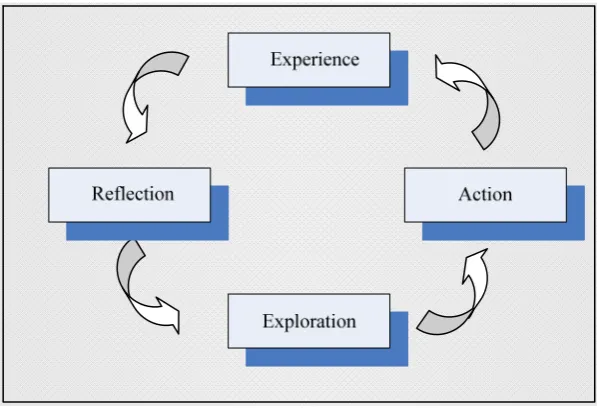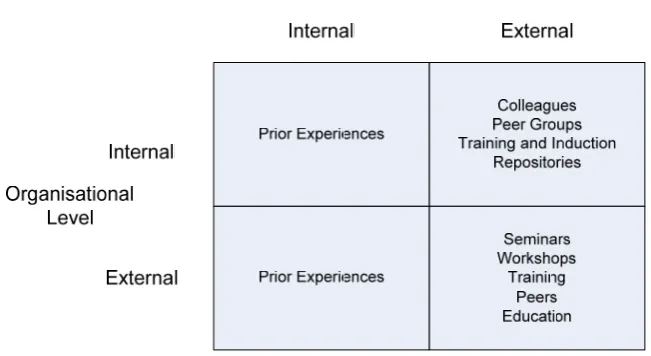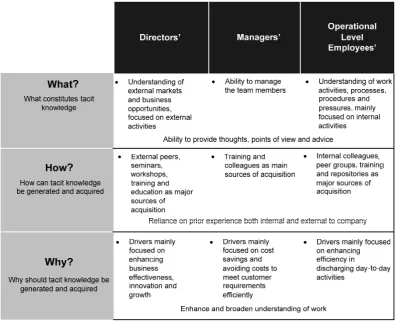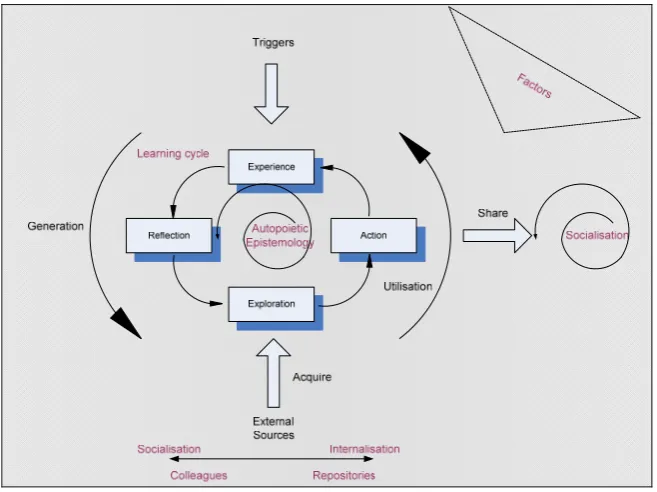The role of tacit knowledge in the
construction industry: towards a definition
Pathirage, CP, Amaratunga, RDG and Haigh, RP
Title
The role of tacit knowledge in the construction industry: towards a
definition
Authors
Pathirage, CP, Amaratunga, RDG and Haigh, RP
Type
Conference or Workshop Item
URL
This version is available at: http://usir.salford.ac.uk/9814/
Published Date
2008
USIR is a digital collection of the research output of the University of Salford. Where copyright
permits, full text material held in the repository is made freely available online and can be read,
downloaded and copied for noncommercial private study or research purposes. Please check the
manuscript for any further copyright restrictions.
The role of tacit knowledge in the construction
industry: towards a definition
Chaminda Pathirage,
Research Institute for the Built and Human Environment, University of Salford (email: c.p.pathirage@salford.ac.uk)
Dilanthi Amaratunga,
Research Institute for the Built and Human Environment, University of Salford (email: r.d.g.amaratunga@salford.ac.uk)
Richard Haigh,
Research Institute for the Built and Human Environment, University of Salford (email: r.p.haigh@salford.ac.uk)
Abstract
The construction industry is perceived as one of the knowledge-based value creating sectors of the economy; however, it faces many challenges, especially in terms of performance, due to its intrinsic nature. Different knowledge-based solutions have been proposed in the past to overcome this problem. However, the process-based solutions, enhancing personalisation strategies and interactions between construction workers to generate and share tacit knowledge, would be much more relevant to overcome KM problems in construction organisations. As the initial step towards the management of tacit knowledge, this paper examines the nature and importance of tacit knowledge in the construction industry. Based on research findings a definition for tacit knowledge is synthesised to: understanding, capabilities, skills and the experiences of individuals; often expressed in human actions in the form of thoughts, points of view, evaluation and advice; generated and acquired through past experiences, individuals, and repositories; utilised for the benefit of individual and organisational development.
Keywords: Tacit knowledge, Construction industry, Generation and utilisation.
1. Background
specifically disseminate tacit knowledge through person-to-person approaches, are considered when knowledge is seen as a ‘flow’. Accordingly, two distinct strategies have been identified for developing Knowledge Management (KM) systems: codification and personalisation [4]. A codification strategy revolves around explicit knowledge, captured and leveraged using IT-tools i.e. software such as expert systems, artificial intelligence and data mining tools, which are known as ‘KM technologies’ [5]. Personalisation, at the other extreme, revolves around tacit knowledge, using non-IT tools or human interactive systems such as knowledge sharing networks [6], communities of practice [7], brainstorming, action learning, post- project reviews and so forth, which are known as ‘KM techniques’.
Different knowledge based solutions have been proposed in the construction industry to promote knowledge sharing. However, previous work on KM in the industry has concentrated heavily on the delivery of technological solutions [8,9], hence also on KM technologies, mainly due to the increased focus on IT during the past decade. The tacit knowledge of construction employees has often been ignored or placed with less importance, as evident from the current focus on KM in the construction industry [9], and inadequate empirical studies carried out in the construction industry. In the context of the knowledge economy, the utilisation of tacit knowledge is considered to be the real driver for the performance of the industry [10]. A number of authors, such as Egbu et al., [9], Carrillo et al., [11], Robinson et al., [12], Pathirage
et al., [13], have highlighted the importance of the tacit knowledge of employees in the construction industry. An understanding of what constitutes tacit knowledge would be central to its effective management.
The paper aims to explore the nature and importance of tacit knowledge in the construction industry, based on a doctoral study that investigated the process of tacit knowledge management in a construction organisation. Accordingly, the paper is broadly divided into four sections. Initially, tacit knowledge, and its generation and utilisation are discussed. Secondly the paper introduces the research methodology followed for the research. Next, findings from the pilot interviews and case study investigation are presented. Finally, the paper culminates with a discussion on the nature and importance of tacit knowledge in the construction industry.
2. Tacit Knowledge
could be explained by considering the underpinning epistemological differences in Western and Japanese thinking on tacit knowledge, its codification and diffusion. Literature reveals two fundamentally different and competing schools of thought regarding diffusion and codification of such knowledge. One believes that tacit knowledge can and must be made explicit for sharing and the other regards tacit knowledge as always being tacit, representing the Japanese and Western thinking respectively.
Polanyi [1] sees tacit knowledge as a personal form of knowledge, which individuals can only obtain from direct experience in a given domain. Further, he encapsulates the essence of tacit knowledge in the well-known phrase ‘‘we know more than we can tell’’. According to Polanyi [1], this knowledge is held in a non-verbal form, and therefore, the holder cannot provide a useful verbal explanation to another individual. Moreover, as he contends, tacit knowing is such an elusive and subjective awareness of the individual that it cannot be articulated in words. It is from Polanyi’s argument that the differentiation between tacitness and implicitness was apparent, and from his terminology, tacitness was evidently different from implicitness. Implicitness, another form of expressing knowing, does exist. It implies that one can articulate it but is unwilling to do that because of specific reasons under certain settings such as, intrinsic behaviour in perception, cultural custom, or organisational style. [18]. Therefore, by describing implicit knowledge, Polanyi was referring to the technical dimension of the tacit knowledge, whereas cognitive dimension purely represented the tacit knowledge that he considered as always being tacit.
In Japanese thinking, knowledge is traditionally seen primarily as something not easily visible and expressible, that is, tacit by its nature. Nonaka and Takeuchi asserted that their view on knowledge was human knowledge, and they defined knowledge as a dynamic human process of justifying personal belief toward the ‘‘truth’’ [2]:
“...we classify human knowledge into two kinds. One is explicit knowledge, which can be articulated in formal language including grammatical statements, mathematical expressions, specifications, manuals, and so forth.... A more important kind of knowledge is tacit knowledge, which is hard to articulate with formal language. It is personal knowledge embedded in individual experience and involves intangible factors such as personal belief, perspective, and the value system” (p.viii).
3. Tacit Knowledge Generation And Utilisation
Researchers like Varela et al., [19], von Krogh & Roos [20] and Venzin et al., [21] have based their work on cognitive science, which has been the most influential [22] for scientists studying organisational knowledge. Accordingly, three different epistemologies are suggested i.e. Cognitivist epistemology (represented by Simon, [23]), Connectionistic epistemology (represented by Zander and Kogut, [24]) and Autopoietic epistemology (introduced by Maturana and Varela, [25]), to explain some core questions such as; what is knowledge, how is it generated, and what are the conditions for knowledge to generate? Cognitivist epistemology considers organisations as open systems that develop knowledge by formulating increasingly accurate representation of their predefined world. Data accumulation and dissemination are the major knowledge development activities, the more data that can be gathered the closer the representation is to reality. Hence, as Koskinen [22] asserts, this approach equates knowledge with information and data. In Connectionistic epistemology, however, the rules on how to process information are not universal, but vary depending on the relationship. Organisations are seen as self-organised networks composed of relationships and driven by communication. Similar to the cognitivist, information processing is the basic activity of the system, yet relationships and communication are the most important facets of cognition. Autopoietic epistemology provides a fundamentally different understanding of the inputs into a system. Input is regarded as data only. Autopoietic systems are thus both closed and open i.e. open to data, but closed to information and knowledge, both of which have to be interpreted inside the system. These systems are self-referring and the world is thus not seen as fixed and objective; the world is constructed within the system and it is therefore not possible to ‘represent’ reality [26]. Vicari and Troilo [27] describe this epistemology with the following example;
“When a teacher delivers a speech, two students build different knowledge according to their own attitudes, intelligence and previous knowledge. The transmission by the teacher is the same for the two of them, but the knowledge produced is different” (p. 5).
Figure 1: Kolb’s Experiential Learning Model (Adopted from Kolb, [30])
These four stages could be described as: Experience - provides the basis or trigger for the tacit knowledge generation process e.g. active involvement, new problem; Reflection - gains an understanding of the current experience and process it in a way that makes sense of the experience; Exploration - assimilates and distils the observations and reflections into theory or concept; Action - based upon knowledge gained, develops a way to use and start to put into action. According to Kolb [30], reflection after experience is paramount in order to learn from the past lessons and to generate tacit knowledge. This is further described by Schon [31] who explains how practitioners reflect, based on their tacit knowing. Therefore, Kolb’s experiential learning model is embraced within this study to represent the cognitive process of the tacit knowledge generation and utilisation of construction employees.
4. Research Methodology
employing nearly 8,500 employees, involved in building and infrastructure projects, including facilities management. The overall case study investigation included two phases: an exploratory phase and an explanatory phase. However, this paper reports the findings based on the exploratory phase of the case study investigation only. Eight interviews with company employees representing different levels of the staff i.e. senior level (two directors), middle level (two managers) and operational level (four line employees) were carried out to explore the nature of tacit knowledge.
Interviews, both unstructured and semi-structured, were used as the main research technique for data collection in this study. Unstructured interviews were carried out during the pilot interview phase and semi-structured interviews were used during the exploratory phase of the case study. Exploratory phase interviews were carried out among all three levels of the staff, representing different departments. Hence, the research deployed a triangulation of data combining more than one source of data collection; to develop converging lines of inquiry. A combination of textual analysis and mapping technique, aided by computer software, was used as the main research techniques of data analysis for data collected from unstructured and semi-structured interviews. This began with qualitative content analysis, which is the main technique for analysing data under textual analysis, with the aid of NVivo software (version 2.0) to generate codes, based on related concepts from data collected. Later, cognitive mapping was undertaken, which is the main technique for analysing data under mapping techniques, using Decision Explorer software (academic version 3.1.2) to build relationships among concepts and for better data presentation. This triangulation of data analysis techniques enabled the rigor of structuring, organising and analysing multiple sources of data, and maintenance of the richness of original data.
5. Pilot Interview Results
useful when dealing with complex problem solving situations. All the interviewees therefore recognised the importance of tacit knowledge within the construction industry, and the fact that it is not fully exploited by the construction industry. They considered tacit knowledge as the key to the performance of the industry. As one of the interviewees highlighted:
“…if one tries to find out the types of knowledge that contribute more to innovation and competitiveness, it is tacit knowledge as opposed to explicit knowledge. So there is a need to say tacit knowledge is important and there is even more need to explore that fully, because we still haven’t learned how this sticky knowledge works, especially when you look at knowledge as a stock or a flow across chains, supply chain and networks, intra and inter…”
Furthermore, interview respondents acknowledged that most of the KM initiatives within the construction industry have concentrated on explicit knowledge, whilst the necessity is for tacit knowledge. As they explained, this was due to several reasons, but mainly due to the fact that the origin of modern KM issues has been driven by a technocrat approach, hence driven by IT. Thus, KM has been considered as a mere extension of data management, information management, and knowledge-based systems, and this legacy is still considered to be in existence. In providing further insights on this, one interviewee cited the fact that:
“there is a good reason to suggest that explicit types of knowledge lend themselves more readily to the use of IT and exploitation of IT than the tacit form of knowledge and also, due to the simple reason that explicit knowledge is more codifiable, you can feel it, you can hold it and you can mess around with it”
In summary, interviewees provided insights on tacit knowledge in the construction industry, also admitting the importance of tacit knowledge and the fact that existing KM work in the construction industry is driven by IT.
6. Case Study Findings
Key concepts on tacit knowledge were elicited from the interview participants (representing directors, managers and operational level employees) of the case study company. The identified concepts were categorised into three aspects of tacit knowledge: ‘what’ constitutes tacit knowledge; ‘how’ can tacit knowledge be generated and acquired; and ‘why’ tacit knowledge should be generated and acquired or utilised.
seemed to be more concerned with the externally focused activities. However, the ability to provide thoughts, points of view, evaluations and advice was apparent from all levels of employees.
[image:9.595.97.423.405.583.2]Different sources and triggers of tacit knowledge were explored with the interview participants. Sources of tacit knowledge acquisition included education, training, colleagues, repositories, and prior experiences, whilst new challenges and first time experiences were cited as main triggers for tacit knowledge generation. Directors and managers had sufficient educational background or extensive prior experience to fall back on when faced with problems. Further, they had the greatest opportunity to undergo training programmes and directors mainly participated in external seminars, workshops and training programmes. Hence, they interacted with external peers and maintained a good network, through which they could acquire tacit knowledge. However, for operational level employees, colleagues and peer groups were considered as the major source for acquiring tacit knowledge within the company. Despite the contextual differences of problems, the tacit knowledge acquired from colleagues was considered as highly beneficial to overcome such problems. Moreover, operational level employees relied on their past experiences and rarely on repositories such as company manuals, documents and intranet. An analysis of tacit knowledge sources is given in Figure 2 based on individual and organisational level considerations.
Figure 2: Analysis of sources of tacit knowledge
The motivation for employees to generate and acquire tacit knowledge presented some diverse views among different interview respondents. However, the general consensus on this was the ultimate improvement in business performance through enhanced efficiency and effectiveness, in addition to personal development. For operational level employees the motivation to generate and acquire tacit knowledge was mainly driven by the desire to perform their tasks more efficiently. Hence, they highly valued different opinions, advice, points of view, evaluations, experience; mainly from their colleagues, which could improve the performance of their day-to-day activities.
Table 1: A summary of key concepts elicited on the role and importance of tacit knowledge
7.
Discussion
[image:11.595.134.463.430.676.2]The importance of tacit knowledge within the construction industry can be highlighted from two points: due to intrinsic characteristics of the construction industry, and the popularisation of the ‘knowledge worker’ concept. The unique, complex, relatively low-tech and labour intensive nature of construction projects, and the limited ability to codify construction knowledge are considered as leading features of the industry, which supports tacit knowledge generation and utilisation. The importance of the ‘knowledge worker’ is highlighted by the fact that industry relies on skills, experience and capabilities of construction employees when delivering the products and services. In the context of construction, examples of tacit knowledge included estimating and tendering skills acquired over time through hands-on experience of preparing bids, understanding the construction process, interaction with clients/customers and project team members in the construction supply chain, as well as understanding tender markets. The importance of tacit knowledge in the construction industry was further highlighted by the interviewees in the pilot study. They believed that employees do fall back on experiences, friendship and collaboration when faced with complex projects or challenging situations, as the use of explicit knowledge or IT in such situations is considered to be minimal. Several interviewees believed that tacit knowledge is the key to the performance of the construction industry due to its intrinsic characteristics, and it has recognised the contribution of tacit knowledge towards innovation and competitiveness. In addition, the interviewees stressed the need to fully explore tacit knowledge within the construction industry, since the industry as a whole has not learned how the ‘sticky and messy’ knowledge works.
Figure 3: Tacit knowledge generation and utilisation process
acquired; and ‘why’ tacit knowledge should be generated and utilised. In order to articulate the process of tacit knowledge generation and utilisation, the study integrated theories of experiential learning, cognitive science and knowledge creation. The autopoietic epistemology was preferred as the philosophical basis of understanding tacit knowledge generation and utilisation; whilst Kolb’s [30] experiential learning model was considered in terms of the stages that followed within the cognitive process of tacit knowledge generation and utilisation. Figure 3 summarises the sources of tacit knowledge generation and acquisition together with the individual cognitive process based on case study findings.
Tacit knowledge has been defined as the unarticulated knowledge that resides in human beings, based on experience and expressed in the form of attitudes, points of view and commitment [3,14,22]. This definition of tacit knowledge was used extensively throughout the study; however, the pilot interview outcomes and case study findings provided richer insights on what tacit knowledge is in an organisational context, hence the following definition is synthesised:
Tacit knowledge constitutes understanding, capabilities, skills and the experiences of individuals; often expressed in human actions in the form of thoughts, points of view, evaluations and advice; generated and acquired through past experiences, individuals, and repositories; utilised for the benefit of individual and organisational development.
8. Conclusion
Due to the intrinsic characteristics of the construction industry, tacit knowledge of the workers and their social interactions has gained increasing importance within the industry. As the industry is very much centred on tacit knowledge and experience of construction workers, it is biased towards the process-based view of knowledge. Hence, the process-based solutions, enhancing personalisation strategies and interactions between construction workers to generate and share tacit knowledge, would be much more relevant to overcome KM problems in construction organisations. Understanding what tacit knowledge is, its generation and utilisation are central to its effective management. Accordingly, this paper explored and discussed the nature and importance of tacit knowledge in the construction industry, based on a doctoral study which investigated the process of tacit knowledge management in a construction organisation.
References
[1] Polanyi, M. (1958) Personal Knowledge Towards a Post-critical Philosophy. Routledge and Kegan Paul Ltd, London
[2] Nonaka, I., and Takeuchi, H. (1995) The knowledge creating company: How Japanese companies create the dynamics of innovation. Oxford University Press, New York
[4] Hansen, M.T., Nohria, N., and Tierney, T. (1999) What’s your strategy for managing knowledge. Harvard Business Review, Vol. 77 (March-April), pp. 106-116.
[5] Al-Ghassani, A.M., Anumba, C.J., Carrillo, P.M., and Robinson, H.S. (2005) Tools and techniques for knowledge management. In: Anumba, C.J., Egbu, C.O., and Carrillo, P. (Eds), Knowledge Management in Construction, Blackwell, UK
[6] Dyer, J.H., and Nobeoka, K. (2000) Creating and managing a high performance knowledge-sharing network: the Toyota case. Strategic Management Journal, Vol. 21, No3, pp. 345-67.
[7] Wenger, E., McDermott, R., and Synder, W. (2000) Cultivating Communities of Practice. Harvard Business School Publishing, Boston, MA
[8] Carrillo, P.M., Anumba, C.J., and Kamara, J.M. (2000), Knowledge management for construction: key IT and contextual issues. In: Gudnason, G. (Ed.) Proceedings of the International Conference on Construction IT, 28-30 June, Reykjavik, Iceland, Icelandic Building Research Institute, pp. 155-165.
[9] Egbu, C., Kurul, E., Quintas, P., Hutchinson, V., Anumba, C. and Ruikar, K. (2003) Knowledge production, resources and capabilities in the construction industry. Work package 1-final report, Knowledge management for sustainable construction competitiveness project, Available from: www.knowledgemanagement.uk.net
[10] Quintas, P. (2005) The nature and dimensions of knowledge management. In: Anumba, C.J., Egbu, C.O., and Carrillo, P. (Eds), Knowledge Management in Construction, Blackwell, UK
[11] Carrillo, P.M., Robinson, H. S., Al-Ghassani, A.M., and Anumba, C.J. (2002) Survey of Knowledge Management in Construction. KnowBiz Project Technical Report, Department of Civil and Building Engineering, Loughborough University, UK
[12] Robinson, H.S., Carrillo, M.P., Anumba, C.J. and Al-Ghassani, A.M. (2001) Linking knowledge management strategy to business performance in construction organisations. In: Akintoye, A. (Ed.), 17th Annual ARCOM conference, 5-7th September, Association of Researchers in Construction Management, University of Salford
[13] Pathirage, C.P., Amaratunga, D. and Haigh, R. (2007) Tacit knowledge and organisational performance: Construction industry perspective. The Journal of Knowledge Management, Vol. 11, No1, pp. 115- 126.
[15] Empson, L. (1999) The challenge of managing knowledge. Financial times: Mastering strategy, 4th October.
[16] Empson, L. (2001) Introduction: Human Relations. Special Issue on Knowledge Management in Professional Service Firms, Vol. 54, No7, pp. 811–817.
[17] Gore, C. and Gore, E. (1999) Knowledge management: the way forward. Total Quality management, Vol. 10, No 4-5, pp. 554-60.
[18] Li , M., and Gao, F. (2003) Why Nonaka highlights tacit knowledge: a critical review. Journal of Knowledge Management, Vol. 7, No 4, pp. 6-14.
[19] Varela, F., Thompson, E., and Rosch, E. (1991) Embodied Mind, Cognitive Science and Human Experience. MIT Press, Cambridge
[20] von Krogh, G., and Roos, J. (1995) Organisational Epistemology. Macmillan and St Martin’s Press, New York
[21] Venzin, M., von Krogh, G., and Roos, J. (1998) Future research into knowledge management. In: von Krogh, G., Roos, J., and Kleine, D. (Eds), Knowing in firms, SAGE Publications, London
[22] Koskinen, K.U. (2001) Management of tacit knowledge in a project work context. Act Polytechnica Scandinavica, Industrial Management and Business Administration Series No. 10, Pori School of Technology and Economics, Espoo.
[23] Simon, H. (1982) Models of Bounded Rationality. Vol. 2, MIT Press, Boston
[24] Zander, U., and Kogut, B. (1995) Knowledge and the speed of transfer and imitation of organisational capabilities: an empirical test. Organisation Science, Vol. 6, No1, pp. 76-92.
[25] Maturana, H.R., and Varela, T.J. (1980) Autopoeisis and Cognition. Reidl, London
[26] Sveiby, K.E. (2001) A knowledge based theory of the firm to guide strategy formulation. Journal of Intellectual Capital, Vol. 2, No 4, pp. 344-358.
[27] Vicari, S., and Troilo, G. (1999) Organisational creativity: a new perspective from Cognitive system theory. In: von Krough, G., Nonaka, I., and Nshiguchi, T., (Eds), Knowledge creation: A source of Value, Macmillan Press Ltd, London
[29] Bresnen, M., Edelman, L., Newell, S., Scarbrough, H., and Swan, J. (2003) Social practices and the management of knowledge in project environments. International Journal of Project Management, Vol. 21, No 3, pp. 157-166.



